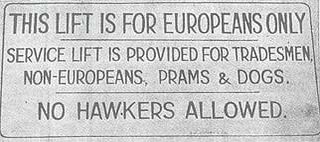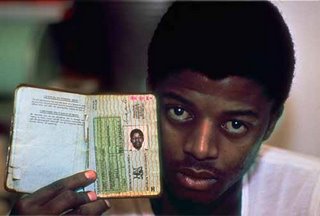The Population Registration Act classified people as Bantu (black Africans), colored (people of mixed race), white (the descendants of the Boers and the British), and Asian (Indian and Pakistani immigrants). Classification into these categories was based on appearance, social acceptance, and descent. For example, a white person was defined as “in appearance obviously a white person or generally accepted as a white person.” A person could not be considered white if one of his or her parents were non-white. The determination that a person was “obviously white” would take into account “his habits, education, and speech and deportment and demeanor.” The subjectivity of these qualifications left a lot of room for the discretion of the authorities, all of whom were of course white. Another common method was the “pencil test” in which the authorities would place a pencil in a person’s hair – if it stuck they were black, if it dropped they were not. The large number of reclassifications on record is an indication of how inaccurate the notion of “race” really is.

The Reservation of Separate Amenities Act Forced segregation in all public amenities, public buildings, and public transport with the aim of eliminating contact between whites and other races. "Europeans Only" and "Non-Europeans Only" signs were put up. The act stated that facilities provided for different races need not be equal.
 The Group Areas Act established separate sections for each race. Members of other races were forbidden to live, work, or own land in areas belonging to other races. A part of this was the dreaded Pass Laws which required non-whites to carry a “pass” to prove they had permission to travel in white areas. Failure to produce a pass led to imprisonment.
The Group Areas Act established separate sections for each race. Members of other races were forbidden to live, work, or own land in areas belonging to other races. A part of this was the dreaded Pass Laws which required non-whites to carry a “pass” to prove they had permission to travel in white areas. Failure to produce a pass led to imprisonment.The Bantu Homelands Citizenship Act created several small “nations” within South Africa for black South Africans. All black South Africans, regardless of where they lived, were made citizens of their “homelands” and thus were excluded from participating in the governing of South Africa.
Bantu Education Act established a Black Education Department in the Department of Native Affairs which would compile a curriculum that suited the "nature and requirements of the black people". The author of the legislation, Dr Hendrik Verwoerd (then Minister of Native Affairs, later Prime Minister), stated that its aim was to prevent Africans from receiving an education that would lead them to aspire to positions they wouldn't be allowed to hold in society. How thoughtful! Instead Africans were to receive an education designed to provide them with skills to suit their own capacities or to work in laboring jobs under whites. In this way it was ensured that no African could exceed the low expectations that their racist government had for them. As a teacher I found this one particularly disgusting.
The full extent of the damage that the apartheid experiment has had on South Africa’s people cannot be told. It is amazing to think that this was the way of life here as recently as the early 90’s.
No comments:
Post a Comment